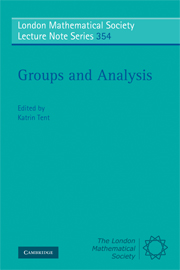Book contents
- Frontmatter
- Contents
- Preface
- List of speakers and talks
- 1 Harmonic analysis on compact symmetric spaces
- 2 Weyl, eigenfunction expansions, symmetric spaces
- 3 Weyl's work on singular Sturm–Liouville operators
- 4 From Weyl quantization to modern algebraic index theory
- 5 Sharp spectral inequalities for the Heisenberg Laplacian
- 6 Equidistribution for quadratic differentials
- 7 Weyl's law in the theory of automorphic forms
- 8 Weyl's Lemma, one of many
- 9 Analysis on foliated spaces and arithmetic geometry
- 10 Reciprocity algebras and branching
- 11 Character formulae from Hermann Weyl to the present
- 12 The Classification of affine buildings
- 13 Emmy Noether and Hermann Weyl
3 - Weyl's work on singular Sturm–Liouville operators
Published online by Cambridge University Press: 12 May 2010
- Frontmatter
- Contents
- Preface
- List of speakers and talks
- 1 Harmonic analysis on compact symmetric spaces
- 2 Weyl, eigenfunction expansions, symmetric spaces
- 3 Weyl's work on singular Sturm–Liouville operators
- 4 From Weyl quantization to modern algebraic index theory
- 5 Sharp spectral inequalities for the Heisenberg Laplacian
- 6 Equidistribution for quadratic differentials
- 7 Weyl's law in the theory of automorphic forms
- 8 Weyl's Lemma, one of many
- 9 Analysis on foliated spaces and arithmetic geometry
- 10 Reciprocity algebras and branching
- 11 Character formulae from Hermann Weyl to the present
- 12 The Classification of affine buildings
- 13 Emmy Noether and Hermann Weyl
Summary
Wie doch ein einziger Reicher so viele Bettler in Nahrung Setzt! Wenn die Könige baun, haben die Kärrner zu tun.
(Schiller, Kant und seine Ausleger)Abstract
Up to the year 1910 there had been many significant mathematical contributions to the theory of linear ordinary differential, and of linear integral equations. Many of these advances were based on the original studies initiated by Sturm and Liouville commencing in 1829. In the closing years of the 19th century the work lead by the Göttingen school of mathematics gave a much needed overview of these significant and varied contributions to mathematical analysis.
The contributions of Hermann Weyl, in and around the year 1910, to the theory of Sturm-Liouville theory heralded the modern analytical and spectral study of boundary value problems. In particular the paper written for Mathematischen Annalen in 1910 stands today as a landmark not only in Sturm-Liouville theory, but in the development of mathematical analysis in the 20th century.
This paper discusses the work of Weyl, and indeed of the Göttingen school of mathematics, in introducing the now familiar terms of Sturm-Liouville theory; limit-point and limit-circle endpoint classifications; the point, continuous and essential spectra; singular eigenfunction expansions; and the interplay of these results with the development of quantum theory in physics.
Introduction
The investigation of second-order linear ordinary differential equations has a long and fascinating history, extending back to the middle of the 18th century. It shaped the concept of a function, led to Cantor's set theory and influenced the theories of measure and integration. It was essential to solving the initial-boundary-value problems for partial differential equations, for example the heat and wave equations, by separation of the variables.
- Type
- Chapter
- Information
- Groups and AnalysisThe Legacy of Hermann Weyl, pp. 63 - 83Publisher: Cambridge University PressPrint publication year: 2008
- 1
- Cited by



